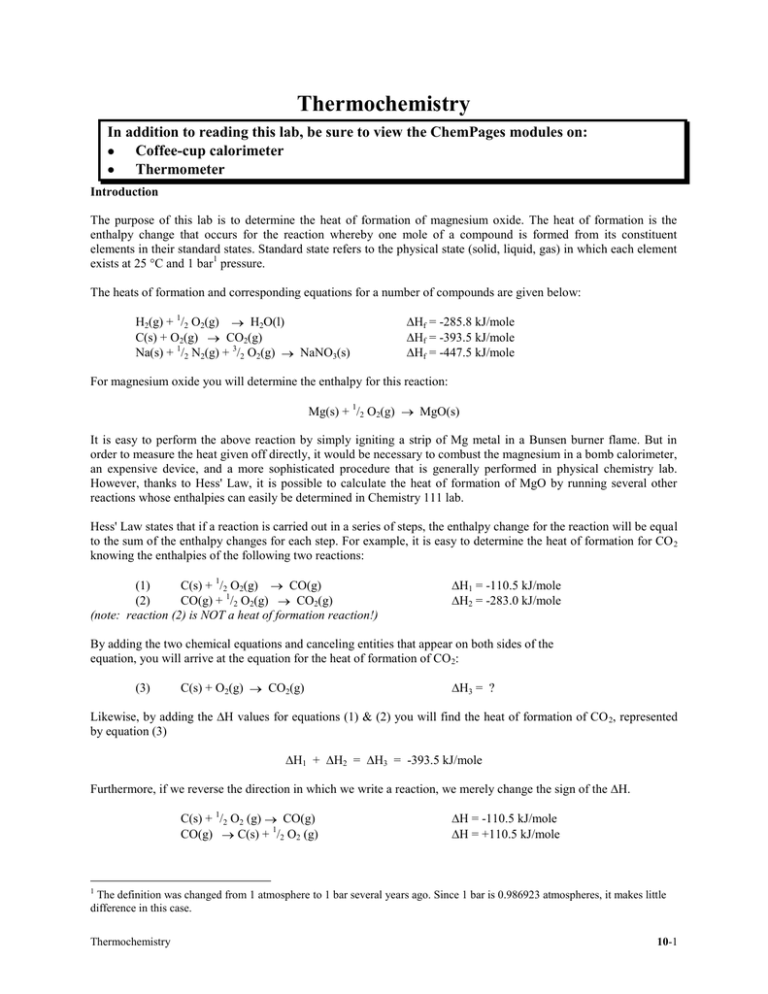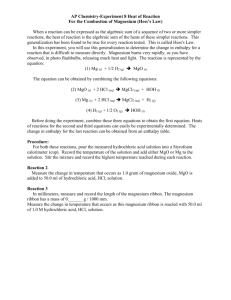Thermochemistry
advertisement

Thermochemistry In addition to reading this lab, be sure to view the ChemPages modules on: Coffee-cup calorimeter Thermometer Introduction The purpose of this lab is to determine the heat of formation of magnesium oxide. The heat of formation is the enthalpy change that occurs for the reaction whereby one mole of a compound is formed from its constituent elements in their standard states. Standard state refers to the physical state (solid, liquid, gas) in which each element exists at 25 °C and 1 bar1 pressure. The heats of formation and corresponding equations for a number of compounds are given below: H2(g) + 1/2 O2(g) H2O(l) C(s) + O2(g) CO2(g) Na(s) + 1/2 N2(g) + 3/2 O2(g) NaNO3(s) ∆Hf = -285.8 kJ/mole ∆Hf = -393.5 kJ/mole ∆Hf = -447.5 kJ/mole For magnesium oxide you will determine the enthalpy for this reaction: Mg(s) + 1/2 O2(g) MgO(s) It is easy to perform the above reaction by simply igniting a strip of Mg metal in a Bunsen burner flame. But in order to measure the heat given off directly, it would be necessary to combust the magnesium in a bomb calorimeter, an expensive device, and a more sophisticated procedure that is generally performed in physical chemistry lab. However, thanks to Hess' Law, it is possible to calculate the heat of formation of MgO by running several other reactions whose enthalpies can easily be determined in Chemistry 111 lab. Hess' Law states that if a reaction is carried out in a series of steps, the enthalpy change for the reaction will be equal to the sum of the enthalpy changes for each step. For example, it is easy to determine the heat of formation for CO 2 knowing the enthalpies of the following two reactions: (1) C(s) + 1/2 O2(g) CO(g) (2) CO(g) + 1/2 O2(g) CO2(g) (note: reaction (2) is NOT a heat of formation reaction!) ∆H1 = -110.5 kJ/mole ∆H2 = -283.0 kJ/mole By adding the two chemical equations and canceling entities that appear on both sides of the equation, you will arrive at the equation for the heat of formation of CO 2: (3) C(s) + O2(g) CO2(g) ∆H3 = ? Likewise, by adding the ∆H values for equations (1) & (2) you will find the heat of formation of CO 2, represented by equation (3) ∆H1 + ∆H2 = ∆H3 = -393.5 kJ/mole Furthermore, if we reverse the direction in which we write a reaction, we merely change the sign of the ∆H. C(s) + 1/2 O2 (g) CO(g) CO(g) C(s) + 1/2 O2 (g) ∆H = -110.5 kJ/mole ∆H = +110.5 kJ/mole 1 The definition was changed from 1 atmosphere to 1 bar several years ago. Since 1 bar is 0.986923 atmospheres, it makes little difference in this case. Thermochemistry 10-1





